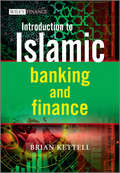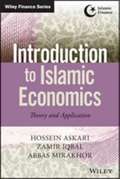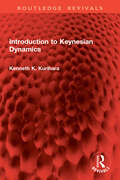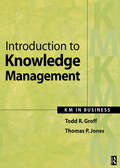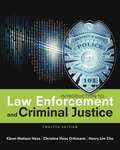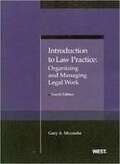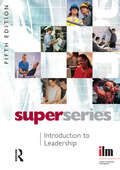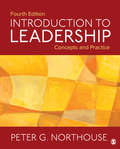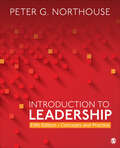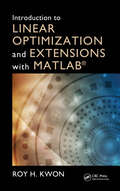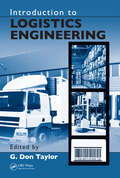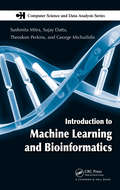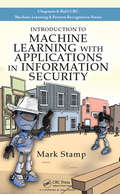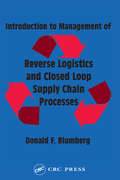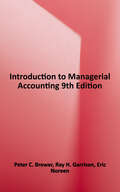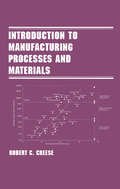- Table View
- List View
Introduction to Islamic Banking and Finance
by Brian KettellIntroduction to Islamic Banking and Finance is a succinct guide to the key characteristics of Islamic banking highlighting how these differ from conventional banking. This detailed book illustrates how Islamic banking is consistent with the Sharia'a, a key element of which is the prohibition on collecting and paying interest. This central religious precept appears to rule out most aspects of modern finance but it does allow money to be used for trading tangible assets and business, which can then generate a profit. Brian Kettell's book looks at all aspects of Islamic banking, including chapters on its creation and evolution through to detailed discussions of the issues involved in the Sharia'a contracts of Murabaha, Mudaraba, Musharaka, Ijara, Istisna'a, and Salam. Islamic insurance (Takaful) is also covered. Finally the book takes a look at Sharia'a law and Sharia'a boards, indicating the roles and responsibilities that come with membership.Islamic banks have been operating in places such as Bahrain, Saudi Arabia, Malaysia and Dubai for some time. Conventional bankers have traditionally viewed the sector as a small, exotic niche but recent years have seen a dramatic surge in popularity. A number of Western investment banks have started working with Muslim clerics to create new ranges of financial products designed for devout Muslims, a large and growing market. Although estimates of the size of the Islamic finance industry vary greatly, everyone agrees that it is expanding rapidly and this is the perfect book for anyone looking to understand the industry.
Introduction to Islamic Economics
by Abbas Mirakhor Zamir Iqbal Hossein AskariGain deeper insight into the principles and theory of Islamic economicsIntroduction to Islamic Economics: Theory and Application provides an overview of the organizing principles and fundamentals of an Islamic economy. With deep discussion of the characteristics, rationale, key institutions, objectives, and instruments at work, the book addresses the core economic principles underlying a system based on the foundational teachings of Islam, and examines the implications for economic policies. Social welfare, economic justice, market functionality, efficiency, and equity are explored from an Islamic perspective, and the role and instruments of fiscal and monetary policy in Islamic systems are used to illustrate contemporary applications.Universities around the globe are offering courses on Islamic economics and finance, but despite the industry's rapid growth, most research has been focused on the financial principles rather than underlying economic principles. The first book of its kind, Introduction to Islamic Economics brings all the key concepts together into one reference volume. By outlining the ways in which Islamic finance and Islamic economics interrelate, this book can help readers to:Develop an understanding of the Islamic economic system and its institutional scaffoldingDifferentiate between the major characteristics of the dominant conventional economy and one based on the fundamental sources of IslamUnderstand the conditions that must be met for a just, well-balanced, stable, and growing economyClarify the role of State, public policy, and risk-sharing in the Islamic financial systemThe Islamic financial system is expanding quickly, and those looking to increase their relevance in a changing economic landscape must get up to speed. Introduction to Islamic Economics provides a comprehensive overview of underlying economic system offering a deeper understanding of the feature of the system. This book is an excellent complement to Introduction to Islamic Finance, 2E by Iqbal and Mirakhor.
Introduction to Islamic Finance
by Benjamin C. Esty Mathew Mateo Millett Fuaad A. QureshiProvides a basic introduction to the principles of Islamic finance. Examines the religious background and legal foundations of Islamic finance. Also discusses the development of Islamic financial institutions and the financial instruments they use. Concludes with a discussion of recent developments and future challenges for this growing segment of the global financial system.
Introduction to Keynesian Dynamics (Routledge Revivals)
by Kenneth K. KuriharaFirst published in 1956, Introduction to Keynesian Dynamics provides a coherent and compact study of macro-dynamic analysis in general and particularly the two outstanding ‘post Keynesian’ developments in the field- 1) dynamic theories of cyclical fluctuations and 2) secular growth analysis.Part I of this book provides a general base of reference for substantive analysis. Part II contains fairly definitive materials, dealing as it does with the modus operandi of cyclical fluctuations, the dynamics of inflation and deflation, the stability conditions of equilibrium, a nonlinear model of dynamic switches, the interaction of endogenous and exogenous variables, and international oscillatory processes. Part III explores the technical possibility and difficulty of securing maximum economic growth with minimum instability. The concluding chapter critically examines the twin problems of steady growth for advanced economies and rapid development for underdeveloped economies in a way that would suggest a common solution. This is a must read for students of economics and economic history.
Introduction to Knowledge Management: Km In Business
by Thomas Jones Todd GroffThis book introduces readers to a wide range of knowledge management (KM) tools, techniques and terminology for enhancing innovation, communication and dedication among individuals and workgroups. The focus is on real-world business examples using commonly available technologies. The book is set out in a clear and straightforward way, with definitions highlighted, brief case studies included that illustrate key points, dialogue sections that probe for practical applications, and written exercises. Each chapter concludes with discussion questions, review questions, and a vocabulary review. An Online Instructor's Guide is available.
Introduction to Law Enforcement and Criminal Justice
by Christine Hess Orthmann Kären Matison Hess Henry Lim ChoThis comprehensive and practical book covers law enforcement and the criminal justice system as a whole (including courts, corrections, and juvenile justice) in one easy-to-understand volume. You'll find a realistic and relevant "boots on the street" perspective, real world examples in every chapter, and up-to-date information on a wide range of today's hottest topics. You'll learn about the ways technology is changing the day-to-day operations of policing and police interaction with the public; the recommendations of the President's Task Force on 21st Century Policing, including the need to improve trust and legitimacy with the public and a shift away from the warrior mentality to a guardian mindset; the law enforcement response to new terrorism threats such as ISIS and homegrown violent extremists; drones and other new surveillance techniques; and more.
Introduction to Law Firm Practice
by Michael DowneyWriting for law school students expecting to enter a private law firm after graduation, Downey (Washington U. School of Law in St. Louis) describes how law firms operate and are managed. Chapters address such topics as office-sharing arrangements, referral arrangements outside law firms, the form of law firms, law firm governance, types of lawyers in law firms, administrative organizational structures, interactions with non-lawyer staff, partnerships, the market for legal services, types of law practices, how fees are assessed, other sources of firm revenue, law firm profitability, client and matter profitability, compensation, intake of a client matter, time billing, managing client work, pro bono work, business development, client relationship management, lending clients money, firm culture and demands on time, lawyer's professional liability insurance, potential malpractice claims, disciplinary complaints, diversity in law firms, mentoring, and supervision and risk management. Annotation ©2011 Book News, Inc. , Portland, OR (booknews. com)
Introduction to Law Practice: Organizing and Managing Legal Work
by Gary A. MunnekeThis casebook introduces practice management skills in a variety of areas, including formation of a firm, development of a marketing plan, hiring and retaining staff, setting up a law office, leveraging the lawyer's intellectual work product, marshalling IT resources, establishing office systems, setting and collecting fees, and managing a budget. The new edition features an entirely new first section called "The Business of Law" which focuses on the economics of the profession and looks at the changing business model of law firms and billing practices. This edition also has new sections focusing on creating "practice-ready" lawyers
Introduction to Leadership (Institute of Learning & Management Super Series)
by Institute of Leadership & ManagementSuper series are a set of workbooks to accompany the flexible learning programme specifically designed and developed by the Institute of Leadership & Management (ILM) to support their Level 3 Certificate in First Line Management. The learning content is also closely aligned to the Level 3 S/NVQ in Management. The series consists of 35 workbooks. Each book will map on to a course unit (35 books/units).
Introduction to Leadership: Concepts and Practice
by Dr. Peter G. NorthouseThe Fourth Edition of Peter G. Northouse’s bestselling Introduction to Leadership: Concepts and Practice provides readers with a clear overview of the complexities of practicing leadership and concrete strategies for becoming better leaders. The text is organized around key leader responsibilities such as creating a vision, establishing a constructive climate, listening to outgroup members, and overcoming obstacles. Three interactive components in every chapter—self-assessment questionnaires, observational exercises, and reflection and action worksheets—get readers actively involved in applying leadership concepts to their own lives. Grounded in leadership theory and the latest research, the fully updated, highly practical Fourth Edition includes a new chapter on how leaders can embrace diversity and inclusion, as well as new material on the dark side of leadership and a new ethical leadership style questionnaire.
Introduction to Leadership: Concepts and Practice
by Dr. Peter G. NorthouseThe Fourth Edition of Peter G. Northouse’s bestselling Introduction to Leadership: Concepts and Practice provides readers with a clear overview of the complexities of practicing leadership and concrete strategies for becoming better leaders. The text is organized around key leader responsibilities such as creating a vision, establishing a constructive climate, listening to outgroup members, and overcoming obstacles. Three interactive components in every chapter—self-assessment questionnaires, observational exercises, and reflection and action worksheets—get readers actively involved in applying leadership concepts to their own lives. Grounded in leadership theory and the latest research, the fully updated, highly practical Fourth Edition includes a new chapter on how leaders can embrace diversity and inclusion, as well as new material on the dark side of leadership and a new ethical leadership style questionnaire.
Introduction to Leadership: Concepts and Practice
by Dr. Peter G. NorthouseIncludes new chapter on Destructive Leadership! The Fifth Edition of Peter G. Northouse&’s bestselling Introduction to Leadership: Concepts and Practice provides readers with a clear, concise overview of the complexities of practicing leadership and concrete strategies for becoming better leaders. The text is organized around key leader responsibilities such as creating a vision, establishing a constructive climate, listening to outgroup members, and overcoming obstacles. Case studies, self-assessment questionnaires, observational exercises, and reflection and action worksheets engage readers to apply leadership concepts to their own lives. Grounded in leadership theory and the latest research, the fully updated, highly practical Fifth Edition includes a new chapter on destructive leadership, 18 new cases, and 5 new Leadership Snapshots. Also available as a digital option (courseware). Learn more about Introduction to Leadership: Concepts and Practice, Fifth Edition - Vantage Digital Option.
Introduction to Leadership: Concepts and Practice
by Dr. Peter G. NorthouseIncludes new chapter on Destructive Leadership! The Fifth Edition of Peter G. Northouse&’s bestselling Introduction to Leadership: Concepts and Practice provides readers with a clear, concise overview of the complexities of practicing leadership and concrete strategies for becoming better leaders. The text is organized around key leader responsibilities such as creating a vision, establishing a constructive climate, listening to outgroup members, and overcoming obstacles. Case studies, self-assessment questionnaires, observational exercises, and reflection and action worksheets engage readers to apply leadership concepts to their own lives. Grounded in leadership theory and the latest research, the fully updated, highly practical Fifth Edition includes a new chapter on destructive leadership, 18 new cases, and 5 new Leadership Snapshots. Also available as a digital option (courseware). Learn more about Introduction to Leadership: Concepts and Practice, Fifth Edition - Vantage Digital Option.
Introduction to Leadership: Concepts and Practice
by Peter G. NorthouseNew chapter on Working with Groups! The Sixth Edition of Peter G. Northouse′s best-selling Introduction to Leadership: Concepts and Practice provides readers with a clear, concise overview of the complexities of practicing leadership and concrete strategies for becoming better leaders. The text is organized around key leader responsibilities such as creating a vision, engaging strengths, and managing conflict. Case studies, self-assessment questionnaires, observational exercises, and reflection and action worksheets allow readers to apply leadership concepts to their own lives. Grounded in leadership theory and the latest research, the fully updated, highly practical new edition includes a new chapter on working with groups, 2 new cases, and 6 new Leadership Snapshots.
Introduction to Leadership: Concepts and Practice
by Peter G. NorthouseNew chapter on Working with Groups! The Sixth Edition of Peter G. Northouse′s best-selling Introduction to Leadership: Concepts and Practice provides readers with a clear, concise overview of the complexities of practicing leadership and concrete strategies for becoming better leaders. The text is organized around key leader responsibilities such as creating a vision, engaging strengths, and managing conflict. Case studies, self-assessment questionnaires, observational exercises, and reflection and action worksheets allow readers to apply leadership concepts to their own lives. Grounded in leadership theory and the latest research, the fully updated, highly practical new edition includes a new chapter on working with groups, 2 new cases, and 6 new Leadership Snapshots.
Introduction to Linear Optimization and Extensions with MATLAB (Operations Research Series)
by Roy H. KwonFilling the need for an introductory book on linear programming that discusses the important ways to mitigate parameter uncertainty, Introduction to Linear Optimization and Extensions with MATLAB provides a concrete and intuitive yet rigorous introduction to modern linear optimization. In addition to fundamental topics, the book discusses current l
Introduction to Logistics Engineering
by G. Don TaylorDespite its importance, logistics engineering often lags industry requirements, especially in terms of engineering-based needs. Filling the gap between education and practice, this brief but comprehensive volume covers the most basic material in the field of logistics engineering, making is suitable for those who require an overview of the topic. T
Introduction to Machine Learning and Bioinformatics
by Sushmita Mitra Sujay Datta Theodore Perkins George MichailidisLucidly Integrates Current ActivitiesFocusing on both fundamentals and recent advances, Introduction to Machine Learning and Bioinformatics presents an informative and accessible account of the ways in which these two increasingly intertwined areas relate to each other. Examines Connections between Machine Learning & Bio
Introduction to Machine Learning with Applications in Information Security
by Mark Stamp<p>Introduction to Machine Learning with Applications in Information Security provides a class-tested introduction to a wide variety of machine learning algorithms, reinforced through realistic applications. The book is accessible and doesn’t prove theorems, or otherwise dwell on mathematical theory. The goal is to present topics at an intuitive level, with just enough detail to clarify the underlying concepts. <p>The book covers core machine learning topics in-depth, including Hidden Markov Models, Principal Component Analysis, Support Vector Machines, and Clustering. It also includes coverage of Nearest Neighbors, Neural Networks, Boosting and AdaBoost, Random Forests, Linear Discriminant Analysis, Vector Quantization, Naive Bayes, Regression Analysis, Conditional Random Fields, and Data Analysis. <p>Most of the examples in the book are drawn from the field of information security, with many of the machine learning applications specifically focused on malware. The applications presented are designed to demystify machine learning techniques by providing straightforward scenarios. Many of the exercises in this book require some programming, and basic computing concepts are assumed in a few of the application sections. However, anyone with a modest amount of programming experience should have no trouble with this aspect of the book. <p>Instructor resources, including PowerPoint slides, lecture videos, and other relevant material are provided on an accompanying website: http://www.cs.sjsu.edu/~stamp/ML/. For the reader’s benefit, the figures in the book are also available in electronic form, and in color.
Introduction to Machine Learning with Applications in Information Security (Chapman And Hall/crc Machine Learning And Pattern Recognition Ser.)
by Mark StampIntroduction to Machine Learning with Applications in Information Security, Second Edition provides a classroom-tested introduction to a wide variety of machine learning and deep learning algorithms and techniques, reinforced via realistic applications. The book is accessible and doesn’t prove theorems, or dwell on mathematical theory. The goal is to present topics at an intuitive level, with just enough detail to clarify the underlying concepts. The book covers core classic machine learning topics in depth, including Hidden Markov Models (HMM), Support Vector Machines (SVM), and clustering. Additional machine learning topics include k-Nearest Neighbor (k-NN), boosting, Random Forests, and Linear Discriminant Analysis (LDA). The fundamental deep learning topics of backpropagation, Convolutional Neural Networks (CNN), Multilayer Perceptrons (MLP), and Recurrent Neural Networks (RNN) are covered in depth. A broad range of advanced deep learning architectures are also presented, including Long Short-Term Memory (LSTM), Generative Adversarial Networks (GAN), Extreme Learning Machines (ELM), Residual Networks (ResNet), Deep Belief Networks (DBN), Bidirectional Encoder Representations from Transformers (BERT), and Word2Vec. Finally, several cutting-edge deep learning topics are discussed, including dropout regularization, attention, explainability, and adversarial attacks. Most of the examples in the book are drawn from the field of information security, with many of the machine learning and deep learning applications focused on malware. The applications presented serve to demystify the topics by illustrating the use of various learning techniques in straightforward scenarios. Some of the exercises in this book require programming, and elementary computing concepts are assumed in a few of the application sections. However, anyone with a modest amount of computing experience should have no trouble with this aspect of the book. Instructor resources, including PowerPoint slides, lecture videos, and other relevant material are provided on an accompanying website: http://www.cs.sjsu.edu/~stamp/ML/.
Introduction to Macroeconomics
by Edwin G. Dolan David E. LindseyIncludes case studies for every chapter. Also covers international economic theory and policy.
Introduction to Management of Reverse Logistics and Closed Loop Supply Chain Processes
by Donald F. BlumbergIncreasing legislative and environmental pressure requires businesses to become more responsive to products that either have been returned or that are at the end of their useful lives. Life cycles are getting shorter, and efficient handling can save large amounts of money since many materials can be extracted and reused or redistributed. Reverse lo
Introduction to Managerial Accounting
by Eric W. Noreen Ray H. Garrison Peter C. BrewerBrewer’s Introduction to Managerial Accounting has earned a reputation as the most accessible and readable book on the market. Its manageable chapters and clear presentation point students toward understanding just as the needle of a compass provides direction to travelers. However, the book’s authors also understand that everyone’s destinations are different. Some students will become accountants, while others are destined for careers in management, marketing, or finance. Not only does the Brewer text teach students managerial accounting concepts in a clear and concise way, but it also asks students to consider how the concepts they’re learning will apply to the real-world situations they will eventually confront in their careers. This combination of conceptual understanding and the ability to apply that knowledge directs students toward success, whatever their final destination happens to be.
Introduction to Manufacturing Processes and Materials (Manufacturing Engineering and Materials Processing #Vol. 54)
by Robert CreeseThe first manufacturing book to examine time-based break-even analysis, this landmark reference/text applies cost analysis to a variety of industrial processes, employing a new, problem-based approach to manufacturing procedures, materials, and management. An Introduction to Manufacturing Processes and Materials integrates analysis of material costs and process costs, yielding a realistic, effective approach to planning and executing efficient manufacturing schemes. It discusses tool engineering, particularly in terms of cost for press work, forming dies, and casting patterns, process parameters such as gating and riser design for casting, feeds, and more.
